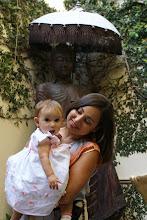After speaking at a recent pregnancy workshop, the following question was raised by 3 expectant moms.
When and how often should we get our babies checked and adjusted?
Although each little bundle is unique in their own way, here is a guide to chiropractic adjustment check points. I will be using the word SUBLUXATION which means any misalignment in the skull, spine, pelvis and extremities that interferes with proper communication between the brain and body. Also, keep in mind that the timeline is not set in stone, and each milestone may not exactly coincide with the listed age.
1. AFTER BIRTH:
the sooner the better
Even a natural, uncomplicated birth can have some negative implications on the baby's health. The position in-utero, the time spent in the birth canal, the body rotation when emerging, the degree of head tilt and force of pull by the delivering practitioner, the delivery of shoulders, use of instruments, and mother's medication, will all have an impact on their Nervous System. Watch Closely for:
- Difficulty Turning Head to one side vs. the other
- Facial Asymmetry
- Moving one side of the body more than the other
- Difficulty Latching On
- Extreme Lethargy
- Inability to lay flat on their back, or hyper extending back and head
- Constant Crying (even when fed and dry)
- Skin color changes
- Shallow breathing
- No muscle tone or grip strength
2. HOLDING HEAD UP: 0-3 months
This is the time when the baby begins to develop her Cervical Curve. Subluxations can lead to muscle imbalance and affect the nerve communication to:
- Eyes
- Ears
- Nose
- Mouth
- Throat
- Caroted and Vertebral Arteries
- Chemoreceptors for O2, CO2, and pH, BP level regulation
- Immune System
3. ROLLING OVER: 3-4 months
Baby begins to strengthen neck rotators and continues to build neck extensors and flexors. Also, strengthening occurs in the upper body and lower lumbar rotators. Subluxations in this area can affect:
- Same as for 0-3 months
- Digestive System
- Detoxification System
- Elimination
4. SITTING UP: 4-6 months
Here the little one is activating and developing Proprioceptors for balance and coordination, strengthening paraspinal muscles, especially lower, and strengthening abdominals. Areas affected by these changes are:
- Eyes
- Ears
- Chest
- Digestive System
- Elimination
5. CRAWLING: 6-8 months
The cross-crawl pattern is essential to developing brain centers responsible for reading comprehension and writing. It also ensures that both sides of the body are being equally strengthened and the brain is receiving balanced information. This is a crucial stage that must not be missed. If the baby goes directly to walking, it is advisable to incorporate cross-crawl activities on a daily basis. Areas affected:
- Neck
- Shoulders and Arms
- Hips and Legs
- Proprioception
- Brain Development
- Coordination
6.
STANDING UP:7-10 months
This is the developing point of the Lumbar Curve. Also loading begins on hips, knees, and ankles. Upper body strength is increasing as the baby uses his arms to pull up and support himself on furniture. Watch for:
- Leg dominance
- Arm dominance
- Foot and Hip rotation
- Any body tilt while standing
Once again it is important not to get ahead of ourselves, or the developing baby. I strongly advise against baby walkers or bouncy swings that prop the growing body up before the muscles and joints are ready to handle that kind of stress. Speeding up the process in this case may actually hinder proper spinal and pelvic development.
7. WALKING: 9-16 months
If your baby has not been checked by this stage, it would be a very good time to do so. This is when we can still catch and correct any subluxations that may have begun over the last few months. Once the child is upright and weight-bearing, they will continue to strengthen all muscles according to what the structural pattern dictates. At this stage key factors to note are:
- Head Position while standing
- Foot and Leg rotation while walking
- Leg bowing or knock-knees
- Any limping or knee buckling
- Direction of falls
8. FOLLOWING FALLS:
any age
Some falls may look worse than others. Some may not look like anything, but are actually more damaging. The falls that don't result in nose bleeds or visible scratches still impact your baby's spine due to their compressive forces. Also, with every fall there is some muscle splinting and straining, which always results in some subluxation. Examples are:
- Falls on shoulders
- Falls straight on the head
- Falls with head getting caught on objects
- Falls landing straight onto the butt
- Trip and falls landing on the face
MY CHIROPRACTIC APPROACH: Birth History. Dietary Review. Family Emotional Background. Full Ears Eyes Nose Throat screening. Spinal and Pelvic Physical Exam. Neurological Exam. Cranial Exam. Orthopoedic Exam. Adjustments may be light manual, with the instrument, or in the form of ligament holds and stretches. CranioSacral therapy also incorporated. On the first 2-3 visits only some adjustments may be applied in order to prevent overwhelming the immature nervous system.



The information you shared in the post is one of the best according to me I have read till now.
ReplyDeleteI will definitely look forward to it and share it out with my friends.
Chiropractic Neurologist Dr. Jacob Bastomski